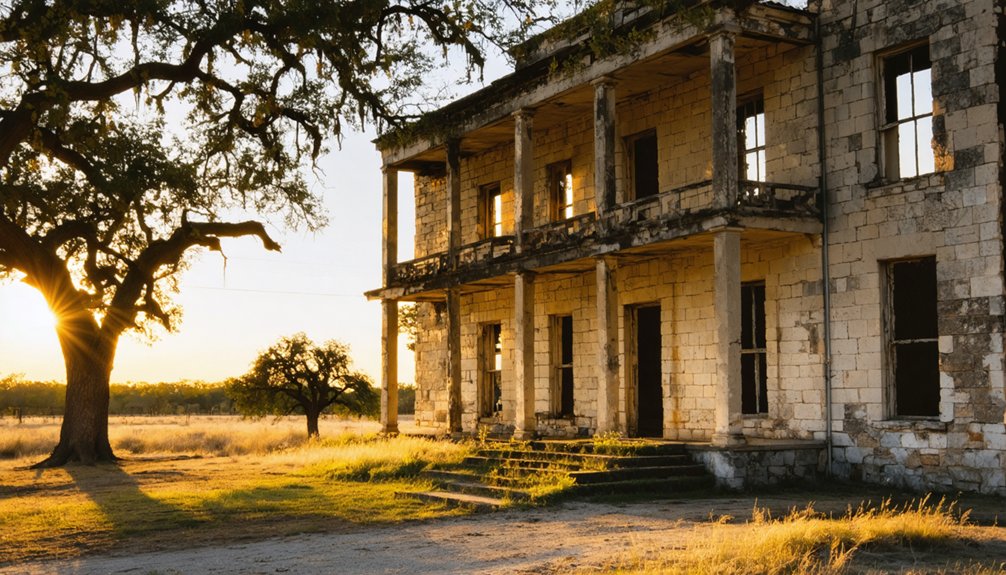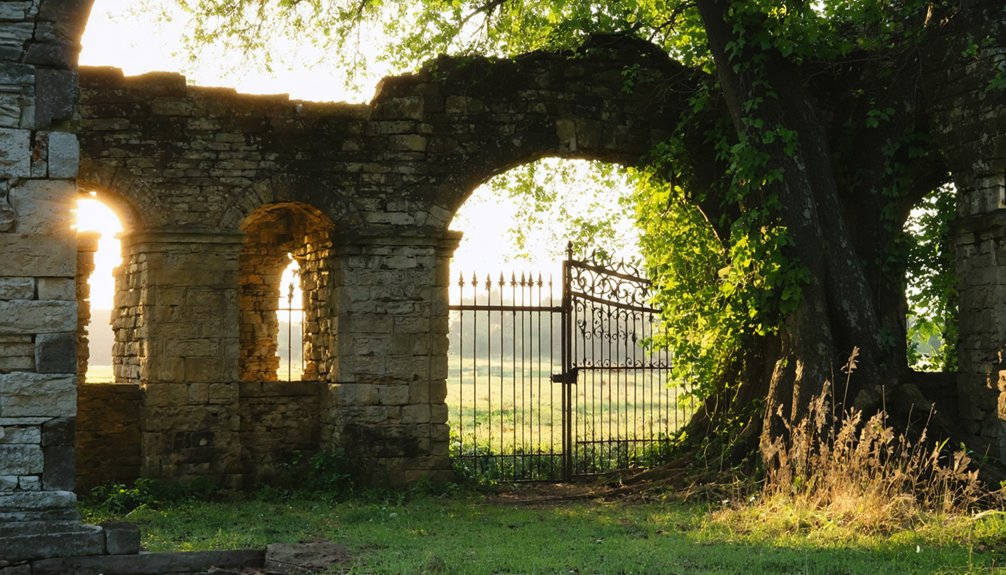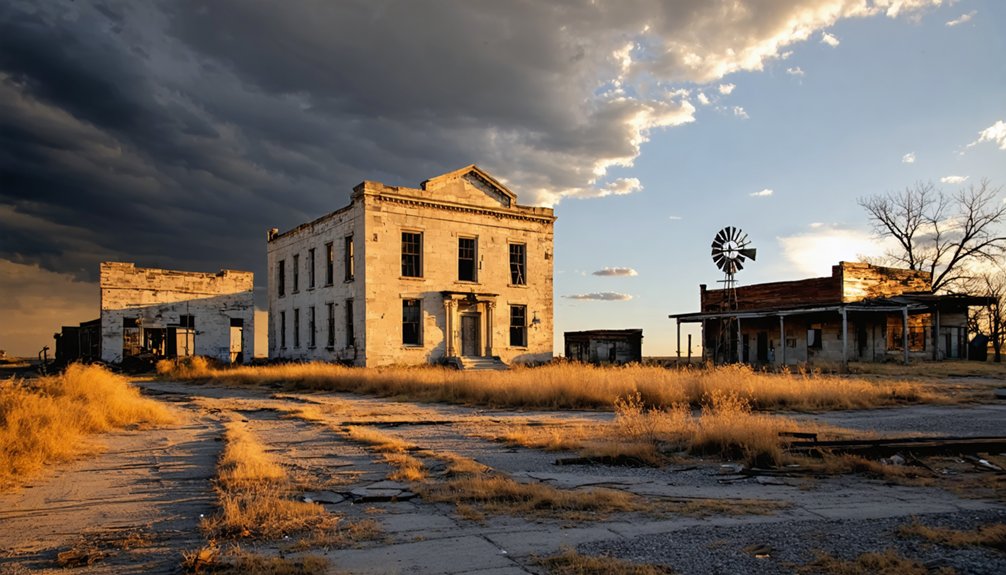You’ll find the haunting remains of Helena, Texas about 60 miles southeast of San Antonio. This former frontier boomtown earned its reputation as the “toughest town on earth” in the 1850s-1870s through frequent gunfights and the infamous “Helena Duel.” When wealthy rancher Colonel Butler rerouted the railroad in revenge, the town’s fate was sealed. Today, you can explore the historic courthouse, jail, and church – where some say the ghosts of Helena’s violent past still linger.
Key Takeaways
- Helena transformed from a thriving Texas frontier town to a ghost town after Colonel Butler’s revenge led to rerouting the railroad elsewhere.
- The town’s violent reputation as “the toughest town on earth” contributed to its decline by deterring railroad investments and legitimate businesses.
- Today, Helena exists as a historic site featuring the 1873 courthouse, old jail, Catholic church, and Latin Cemetery.
- The Karnes County Museum Complex at 8167 N FM 81 preserves Helena’s frontier history and architectural heritage.
- The ghost town is reportedly haunted, with documented paranormal activity including EVP recordings and apparition sightings at various historic buildings.
Origins of a Frontier Boomtown
Two ambitious entrepreneurs, Thomas Ruckman and Lewis Sumpter Owings, established Helena in 1852 on the site of a former Mexican trading post called Álamita. Their founders’ vision positioned the settlement strategically along the Chihuahua Trail, a major route connecting San Antonio and Goliad that would fuel trade expansion throughout the region.
You’ll find that Helena quickly transformed from a modest outpost into a bustling frontier center. Named after Owings’ wife Helen, the town became Karnes County’s seat by 1854, spurring rapid development. The town grew to become one of the largest in Texas during the 1860s and 1870s.
The settlement’s prime location attracted merchants, ranchers, and travelers, leading to the establishment of essential businesses including a gristmill, multiple saloons, and facilities serving the steady stream of freight wagons and cattle drives passing through this promising new community. A thriving commercial district emerged featuring a courthouse, newspaper, and drugstore that served the growing population.
The Wild West’s Most Notorious Settlement
You’ll find that Helena earned its reputation as one of the Wild West’s toughest towns through frequent gunfights, brawls, and outlaw activity centered around its rowdy saloons.
The town’s position along major trade routes attracted a volatile mix of cowboys, criminals, and travelers who regularly engaged in violent confrontations. The notorious Cart War of 1857 erupted when masked raiders targeted Hispanic freight carriers along these routes. The town’s location on the San Antonio River made it a natural gathering point for ranchers and traders.
This lawless culture transformed Helena into an infamous refuge for outlaws in Karnes County, where historic jail cells still stand as evidence of the town’s tumultuous past.
Violence Shaped Town Identity
While many Wild West towns earned reputations for lawlessness, Helena, Texas distinguished itself through a particularly brutal form of ritualized violence called the “Helena Duel.”
In this savage spectacle, fighters had their left hands tied together and wielded three-inch knives, forcing them to endure multiple wounds rather than ending quickly with a fatal strike. These brutal contests drew crowds of spectators who placed bets on the outcomes.
The violence normalization in Helena went beyond typical frontier conflicts. Saloon shootouts occurred regularly, with deadly outcomes like Emmett Butler’s accidental death in 1884. The town’s houses frequently hosted soiled doves who witnessed the endless stream of violence.
The town’s competitive brutality extended through wealthy ranchers like Colonel William G. Butler, who wielded both economic and violent power. From public knife fights to masked raids, Helena’s identity centered on its notorious roughness, earning it the title “toughest town on earth” and ultimately contributing to its decline when the railroad bypassed its violent streets.
Lawless Culture Breeds Chaos
Throughout the late 19th century, Helena, Texas earned its reputation as one of the West’s most notorious outlaw havens, where criminals from across the frontier sought refuge from the law.
The town’s outlaw culture thrived due to its strategic location and limited law enforcement, creating an environment where vigilante justice often prevailed. The ruthless W.G. Butler, a wealthy rancher who was indicted for twenty different killings, exemplified the lawless nature of Helena’s most powerful citizens. The town’s violent legacy is preserved today in the iron jail cells that once housed the county’s most dangerous criminals.
You’ll find Helena’s lawless atmosphere defined by:
- Saloons and gambling halls serving as gathering spots for outlaws and drifters
- Frequent gunfights and shootings in the streets, including the infamous Butler-Leary incident
- Powerful ranchers wielding influence over town officials and law enforcement
- A vice economy that attracted criminals while overwhelming or corrupting local authorities
This chaotic environment ultimately led to Helena’s downfall, as its violent reputation deterred railroad investment and legitimate business development.
Legacy of the Helena Duel
As one of the most distinctive traditions of the American frontier, the Helena Duel left an indelible mark on both local and national culture.
You’ll find its brutal legacy preserved in films, literature, and Hollywood posters that dramatize these infamous knife fights where combatants faced off with bound wrists and three-inch blades. The 1950 film The Iroquois Trail featured this intense form of combat with blades and bound wrists.
The duel traditions reflected Helena’s reputation as the “toughest town on earth,” where both men and women participated in this deadly form of conflict resolution. The town’s decline began after Colonel Butler’s revenge led him to reroute the railroad away from Helena.
In lawless Helena, both genders engaged in ritualized knife duels, cementing the frontier town’s reputation for unmatched toughness.
The cultural significance of these duels extended beyond mere violence – they represented a codified system of justice in a lawless era.
Today, you can explore this dark heritage through Helena’s restored historic buildings and annual commemorations at the old post office.
The Butler Curse and Railroad Bypass
In the aftermath of a tragic saloon brawl on December 26, 1884, Helena’s fate took a dramatic turn when Emmett Butler shot and killed Sheriff Edgar Leary before being gunned down himself by angry townspeople.
When the town refused to identify Emmett’s killers, his father, Colonel William G. Butler, vowed retribution against Helena.
You’ll find the Butler Curse manifested through these pivotal events:
- Colonel Butler negotiated for the San Antonio and Aransas Pass Railway to bypass Helena by seven miles.
- The railroad diversion triggered a mass exodus of businesses and residents.
- Helena lost its county seat status to Karnes City.
- The town’s economic collapse led to its transformation into a ghost town.
Butler’s vengeful strategy proved devastatingly effective, as his railroad deal delivered the fatal blow to Helena’s prosperity.
Historic Buildings and Landmarks Today

Despite its decline from a bustling frontier town to a ghost town, Helena’s historic buildings stand as a tribute to its colorful past.
You’ll find the beautifully restored courthouse, now home to the Karnes County Historical Society Museum, showcasing artifacts and photographs that tell the town’s dramatic story.
Historic preservation efforts have maintained several significant structures, including the old Catholic church and former jail, which serve as anchors of Helena’s architectural significance.
Throughout the town, historical markers and plaques guide you through Helena’s notorious history, marking sites of former saloons and significant events.
The Karnes County Museum Complex at 8167 N FM 81 serves as the heart of local heritage preservation, where you can explore exhibits and watch educational videos about life on the cattle trails.
Tales From Beyond the Grave
While Helena’s historical buildings stand as physical reminders of its past, the town’s supernatural legacy has earned it recognition as one of Texas’s most haunted locations.
You’ll find spectral evidence throughout, from EVP recordings capturing mysterious voices to unexplained physical encounters that leave actual marks on visitors.
- Flora Spratt’s spirit haunts “The Hole” after her tragic 1922 death at the hands of her sheriff husband.
- Christmas Gift Evans’s former home produces ghostly encounters, with orbs and strange noises reported.
- The old courthouse holds photographic proof of apparitions, including a woman’s reflection.
- The Harrin family has documented over 250 EVP sessions, building a significant archive of paranormal activity.
These tales continue drawing investigators and curious visitors seeking to experience Helena’s otherworldly residents firsthand.
Planning Your Visit to Helena’s Ruins

Ready to explore Helena’s historic ruins? You’ll find this fascinating ghost town about 60-70 miles southeast of San Antonio, easily accessible via US Highway 181.
The best time to visit is during special events like the Victorian Tea Party or Indian Heritage Summer Festival, when local guides can enhance your experience.
Before heading out, pack comfortable walking shoes, water, and sun protection – Texas heat doesn’t mess around. You’ll want your camera ready to capture the 1873 courthouse, old jail, and other remaining structures.
While there’s parking near the main sites, including the Karnes County Historical Society Museum, you won’t find many modern amenities.
Visitor tips: bring snacks since dining options are limited, and remember to respect preservation rules while exploring the historic grounds and Latin Cemetery.
Frequently Asked Questions
What Was the Average Population of Helena During Its Peak Years?
You’ll find that population trends show Helena’s peak historical significance during the 1880s, when the town averaged 275 residents, calculated from documented estimates ranging between 250-300 inhabitants.
Did Any Famous Outlaws or Gunfighters Ever Visit Helena?
Like a faded wanted poster, records don’t confirm famous visitors to Helena, though its reputation as “toughest town on earth” surely attracted many outlaw legends passing through South Texas.
How Many People Died in Helena Duels Throughout the Town’s History?
You won’t find exact duel fatality numbers since frontier records weren’t well-kept, but Helena’s historical significance as “toughest town on earth” suggests dozens likely died in these brutal knife fights.
Are There Any Descendants of Original Helena Settlers Still Living Nearby?
Among today’s 200 local residents, you’ll find several families maintaining their legacy in Helena’s surroundings. They preserve local history through the Karnes County Historical Society Museum and community traditions.
What Was the Annual Trade Value Through Helena on the Chihuahua Trail?
You’ll find exact trade values aren’t documented, but Helena’s position on major trade routes suggests substantial commerce worth tens of thousands of dollars annually, given livestock trading’s historical significance during the mid-1800s.
References
- https://authentictexan.com/helena-killed-wrong-man-price/
- https://www.ksat.com/holidays/2015/10/29/spirits-paranormal-activity-reported-on-grounds-of-south-texas-ghost-town/
- https://jollyoutlaw.com/2024/11/helena-ghost-town/
- https://texastimetravel.com/directory/karnes-county-museum/
- https://www.youtube.com/watch?v=7H9qAfObqK8
- https://en.wikipedia.org/wiki/Helena
- https://www.texasescapes.com/TexasGhostTowns/HelenaTexas/HelenaTx.htm
- https://www.tshaonline.org/handbook/entries/helena-tx
- https://pacweb.alamo.edu/InteractiveHistory/projects/rhines/StudentProjects/2001/Helena/Helena.htm
- https://www.county.org/county-magazine-articles/summer-2025/ghost-towns



